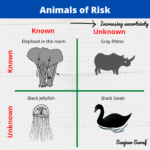LNG import terminals in the U.S. follow NFPA-59A and 49CFR193 standards for facility siting. As a part of the siting studies, LNG regasification facilities report thermal radiation exclusion zones and flammable vapor exclusion zones:
- Flammable vapor hazard zones are based on a design spill from a single accidental source, usually a guillotine rupture.
- Thermal radiation hazards are based on tank fire.
These events used for determining exclusion zones, pipe rupture and tank fire, have a low probability. Surprisingly, the current standards have no requirements to model consequences from high-pressure LNG releases which are more likely. Furthermore, the current codes do not reference Vapor Cloud Explosions (VCE) which directly affects plant layout and siting.
There is high-pressure processing equipment in LNG import and export terminals (e.g. vaporizers in LNG import terminals) that can result in aerosolized release of LNG and can potentially lead to an explosion. Therefore, in addition to the consequence modeling performed for code compliance, facilities must model high pressure releases and VCEs for:
- Optimizing plant layout
- Deciding risk mitigation measures, and
- Terminal/building siting
I discuss issues related to high-pressure releases in a recently presented paper at AIChE conference in Florida.
Sanjeev Saraf, Subodh Medhekar, and En-Hua Yang, “Have You Considered High-Pressure LNG Releases? They Are More Likely Than Catastrophic Failures”.
AIChE members can view the recorded presentation at the following URL:
http://aiche.confex.com/aiche/s09/webprogram/Paper145131.html
If you need further information, please feel free to contact me.



